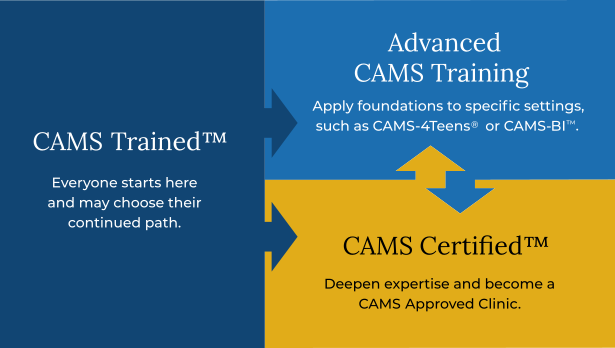Equip your community with an evidence-based approach to treat tribal members with serious thoughts of suicide using the CAMS Framework®.
Training is available for:
- Tribal leaders
- Social workers
- Counselors
- Psychologists
- Community liaisons
- Clinical and crisis staff
Suicide within Indigenous Communities
Indigenous populations have disproportionately high rates of suicide compared to other populations. In 2023, Non-Hispanic American Indian and Alaska Native groups had the highest suicide rates in the U.S.1 Many factors contribute to suicide in these communities. These include poverty, few mental health resources, and a history of oppression and cultural loss.
In recent years, there have been steps taken to address suicide in Tribal Nations. For example, The Native American Suicide Prevention Act has given tribes and tribal organizations the opportunity to collaborate with state governments. Together, they work to develop suicide intervention and prevention strategies. However, there is more work to be done. This is where CAMS can make a lasting impact.
Case Study: Treating Alaska Native Indians
After working on the Kenai Peninsula between 2011 and 2016, Dr. Fridrik Gudmundsson returned in 2019 as a clinician with the Kenaitze Indian Tribe in Alaska. Suicidality in the area is high and, while there is a good level of family support, individuals tend not to seek treatment from medical professionals. According to Dr. Gudmundsson, the Collaborative Assessment and Management of Suicidality (CAMS) lends itself to this population.
How CAMS Can Help
CAMS is an evidence-based, suicide-focused treatment solution. CAMS-care is a training company that provides suicide prevention training to tribal leaders and mental health providers in various roles across and affiliated with Tribal Nations. Rather than following a standard, westernized protocol, CAMS centers on the patient who suffers, focusing on their lived experience. CAMS has been successfully trained and used within indigenous communities and Tribal Nations across various states such as Oklahoma, New Mexico, Alaska, and Arizona.
Benefits of CAMS for Tribal Nations
Adaptable Framework
Because CAMS is centered around the patient and their experiences, it can be implemented into a variety of communities. It honors the traditions and values of the culture—native medicine, community-based healing, therapeutic rituals, and more can be used within the CAMS Framework.
Centered Around Cultural Humility
At CAMS-care, we understand and respect the concerns many Tribal Nations have about using new treatment methods along with their existing practices. This is why we let the nations we work with lead the discussion and aim to work alongside them rather than replace their systems that are already in use.
Reduces Malpractice Risk
CAMS significantly reduces the risk of malpractice due to its use of the Suicide Status Form which provides protective documentation of suicide-focused care. This can help staff feel more confident and comfortable when using it to treat patients.
A Community of Support
When you sign up for CAMS training, you won’t be alone. You’ll have the support of others in the CAMS community to lean on for support and to answer any questions or concerns that may arise.
How CAMS Training Works
CAMS offers training that is designed specifically for those working with Tribal Nations and Native American suicide prevention. Everyone first becomes CAMS Trained™. After receiving the CAMS Trained designation, you and your team can enroll in Advanced CAMS training programs that take your CAMS knowledge further. Advanced CAMS trainings include CAMS-4Teens®. This program helps at-risk young people and their families. It also includes CAMS Brief Intervention. This focuses on using CAMS in emergency situations.

As a clinician who has lost a loved one to suicide, I can vouch for CAMS being not only instructive but also personally healing in helping me feel like I CAN help people who think of suicide.
Evan Merida, MA, LPC, NCC
Sun and Shade Counseling, Denver, CO
The approach of sitting with a client’s thoughts of self harm without immediately jumping to hospitalization has led to better outcomes — both because I’m more confident to stay in that space with them and because that willingness creates a greater trust between us.
CAMS Trained Clinician
Frequently Asked Questions
The best training is one that’s evidence-based, culturally adaptable, and focused on collaborative care. CAMS fits these criteria. It’s empirically supported, flexible across diverse populations, and centers the individual’s experience and context. (CAMS-care, parma.trustinsurance.com)
While CAMS‑care doesn’t publish a specific Indigenous policy, Indigenous suicide prevention policies generally emphasize community-led, culturally rooted care, incorporation of traditional healing and elders, and trauma-informed approaches. These principles form the backbone of effective, respectful interventions.
CAMS emphasizes patient-centered collaboration, meaning it can be culturally adapted, allowing Indigenous clinicians and communities to integrate traditional healing, storytelling, and values-driven approaches into treatment planning. (parma.trustinsurance.com, CAMS-care)
By treating each individual’s suicide risk as a personal journey, CAMS invites integration of community values, traditional knowledge, and cultural strengths. The collaborative approach ensures that Indigenous perspectives, such as relational healing, land-based practices, and holistic wellness, can shape care in meaningful ways.